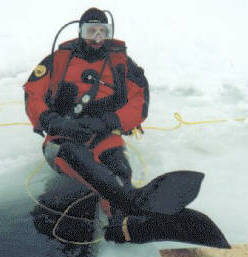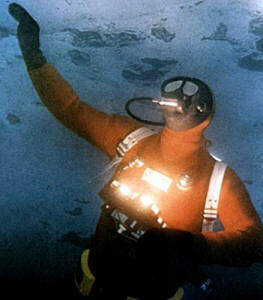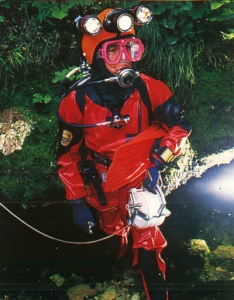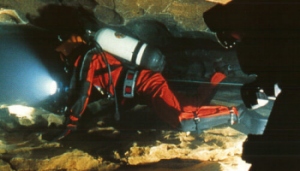 |
Diving under the ice and in dark
cold caves For some divers
the SCUBA-hobby don't stop with the open-water dive, they
want more, they want bigger challenges in the dives. Many
divers who lives in the cold areas of the world dives in
the winter season, both in the cold water or down under
the ice. The cold water gives a very large visibility,
much better than the one in the summer time. Cave diving
is an other form for big challenge dives, the diver goes
down in to large cold and dark caves, not for 1 hour, but
in many time for 4-5 hours at a time.
| ICE
DIVING |
 In
many cold parts of the world, diving in the
winter can be difficult, the water is very cold
and maybe it's even frozen to ice, the diver has
therefor to prepare better for the dive than in
the summer time. The diver has to take classes in
ice-diving, for learning how to react in this
special conditions. If an emergency occurs, it's
not always possible to go direct to the top, the
diver must find the hole in the ice. There are
several common troubles in a ice-dive, the
regulator can freeze, both on an open or a closed
position, the valves on the suit can do the same,
and if the inlet valve freezes in open position
the diver can be send to the surface with a high
speed, with no time for decompression. The
equipment have to be approved for In
many cold parts of the world, diving in the
winter can be difficult, the water is very cold
and maybe it's even frozen to ice, the diver has
therefor to prepare better for the dive than in
the summer time. The diver has to take classes in
ice-diving, for learning how to react in this
special conditions. If an emergency occurs, it's
not always possible to go direct to the top, the
diver must find the hole in the ice. There are
several common troubles in a ice-dive, the
regulator can freeze, both on an open or a closed
position, the valves on the suit can do the same,
and if the inlet valve freezes in open position
the diver can be send to the surface with a high
speed, with no time for decompression. The
equipment have to be approved for  cold water-
and ice-diving. The suit use for this type of
diving is a drysuit with dry gloves. and dryhood.
The suit can be either a neoprene, trilaminate or
rubber. The neoprene suit got a great insulation
special if the divers isn't go to deep into the
water, the pressure will then squeeze the
material and the insulation the be minor. The
shell type suits, (trilaminate or rubber) can of
course also be used, and is it very often
,special if the diver have to wait at the surface
after a dive, the water in the neoprene will then
freeze up and make the suit stiff. Often a full
face mask is used, it will keep the cold water
away from the divers face and made the dive more
safe and comfortable. The diver on the pictures
is just under the ice-surface, dressed in a
neoprene drysuit and a Poseidon full face mask,
called 'monkey face' by reasons obviously to
anyone seen it. cold water-
and ice-diving. The suit use for this type of
diving is a drysuit with dry gloves. and dryhood.
The suit can be either a neoprene, trilaminate or
rubber. The neoprene suit got a great insulation
special if the divers isn't go to deep into the
water, the pressure will then squeeze the
material and the insulation the be minor. The
shell type suits, (trilaminate or rubber) can of
course also be used, and is it very often
,special if the diver have to wait at the surface
after a dive, the water in the neoprene will then
freeze up and make the suit stiff. Often a full
face mask is used, it will keep the cold water
away from the divers face and made the dive more
safe and comfortable. The diver on the pictures
is just under the ice-surface, dressed in a
neoprene drysuit and a Poseidon full face mask,
called 'monkey face' by reasons obviously to
anyone seen it. |

| CAVE
DIVING |
 Cave diving can be
one of the most dangerous types of diving, and
therefor the diver need a special training,
before starting on cave-diving. Cave-diving is
also a very interesting type of diving, thou you
have the opportunity to be places where almost
any peopled had been before. Before going down
into the caves, the diver must obtain detailed
information about the cave, if available. The
equipment used for this type of diving, is must
like the same used in other high-demand diving
environments, a drysuit of a good quality, shell
or neoprene type can be used. The breathing
apparatus can be a normal high-capacity apparatus
which can be equipped with extra tanks for longer
dive time. 2 regulators is used attached to the
tanks, if a regulator should start making
trouble. Cave diving can be
one of the most dangerous types of diving, and
therefor the diver need a special training,
before starting on cave-diving. Cave-diving is
also a very interesting type of diving, thou you
have the opportunity to be places where almost
any peopled had been before. Before going down
into the caves, the diver must obtain detailed
information about the cave, if available. The
equipment used for this type of diving, is must
like the same used in other high-demand diving
environments, a drysuit of a good quality, shell
or neoprene type can be used. The breathing
apparatus can be a normal high-capacity apparatus
which can be equipped with extra tanks for longer
dive time. 2 regulators is used attached to the
tanks, if a regulator should start making
trouble.
 The extra equipment used for
cave diving is a minimum of 3 different light
sources, all to be used un-dependable of each
other, a long line, attach at the opening at the
cave, is pulled all the way in the cave, making
it easier for the diver for find his way out
again. The extra equipment used for
cave diving is a minimum of 3 different light
sources, all to be used un-dependable of each
other, a long line, attach at the opening at the
cave, is pulled all the way in the cave, making
it easier for the diver for find his way out
again.
This
is only a short description of cave-diving, and
is does not fully describe the dangerous of
cave-diving.
|

|

 In
many cold parts of the world, diving in the
winter can be difficult, the water is very cold
and maybe it's even frozen to ice, the diver has
therefor to prepare better for the dive than in
the summer time. The diver has to take classes in
ice-diving, for learning how to react in this
special conditions. If an emergency occurs, it's
not always possible to go direct to the top, the
diver must find the hole in the ice. There are
several common troubles in a ice-dive, the
regulator can freeze, both on an open or a closed
position, the valves on the suit can do the same,
and if the inlet valve freezes in open position
the diver can be send to the surface with a high
speed, with no time for decompression. The
equipment have to be approved for
In
many cold parts of the world, diving in the
winter can be difficult, the water is very cold
and maybe it's even frozen to ice, the diver has
therefor to prepare better for the dive than in
the summer time. The diver has to take classes in
ice-diving, for learning how to react in this
special conditions. If an emergency occurs, it's
not always possible to go direct to the top, the
diver must find the hole in the ice. There are
several common troubles in a ice-dive, the
regulator can freeze, both on an open or a closed
position, the valves on the suit can do the same,
and if the inlet valve freezes in open position
the diver can be send to the surface with a high
speed, with no time for decompression. The
equipment have to be approved for  cold water-
and ice-diving. The suit use for this type of
diving is a drysuit with dry gloves. and dryhood.
The suit can be either a neoprene, trilaminate or
rubber. The neoprene suit got a great insulation
special if the divers isn't go to deep into the
water, the pressure will then squeeze the
material and the insulation the be minor. The
shell type suits, (trilaminate or rubber) can of
course also be used, and is it very often
,special if the diver have to wait at the surface
after a dive, the water in the neoprene will then
freeze up and make the suit stiff. Often a full
face mask is used, it will keep the cold water
away from the divers face and made the dive more
safe and comfortable. The diver on the pictures
is just under the ice-surface, dressed in a
neoprene drysuit and a Poseidon full face mask,
called 'monkey face' by reasons obviously to
anyone seen it.
cold water-
and ice-diving. The suit use for this type of
diving is a drysuit with dry gloves. and dryhood.
The suit can be either a neoprene, trilaminate or
rubber. The neoprene suit got a great insulation
special if the divers isn't go to deep into the
water, the pressure will then squeeze the
material and the insulation the be minor. The
shell type suits, (trilaminate or rubber) can of
course also be used, and is it very often
,special if the diver have to wait at the surface
after a dive, the water in the neoprene will then
freeze up and make the suit stiff. Often a full
face mask is used, it will keep the cold water
away from the divers face and made the dive more
safe and comfortable. The diver on the pictures
is just under the ice-surface, dressed in a
neoprene drysuit and a Poseidon full face mask,
called 'monkey face' by reasons obviously to
anyone seen it.
